CHEVROLET ASTRO PASSENGER 1994 1.G Owners Manual
Manufacturer: CHEVROLET, Model Year: 1994, Model line: ASTRO PASSENGER, Model: CHEVROLET ASTRO PASSENGER 1994 1.GPages: 340, PDF Size: 16.86 MB
Page 151 of 340
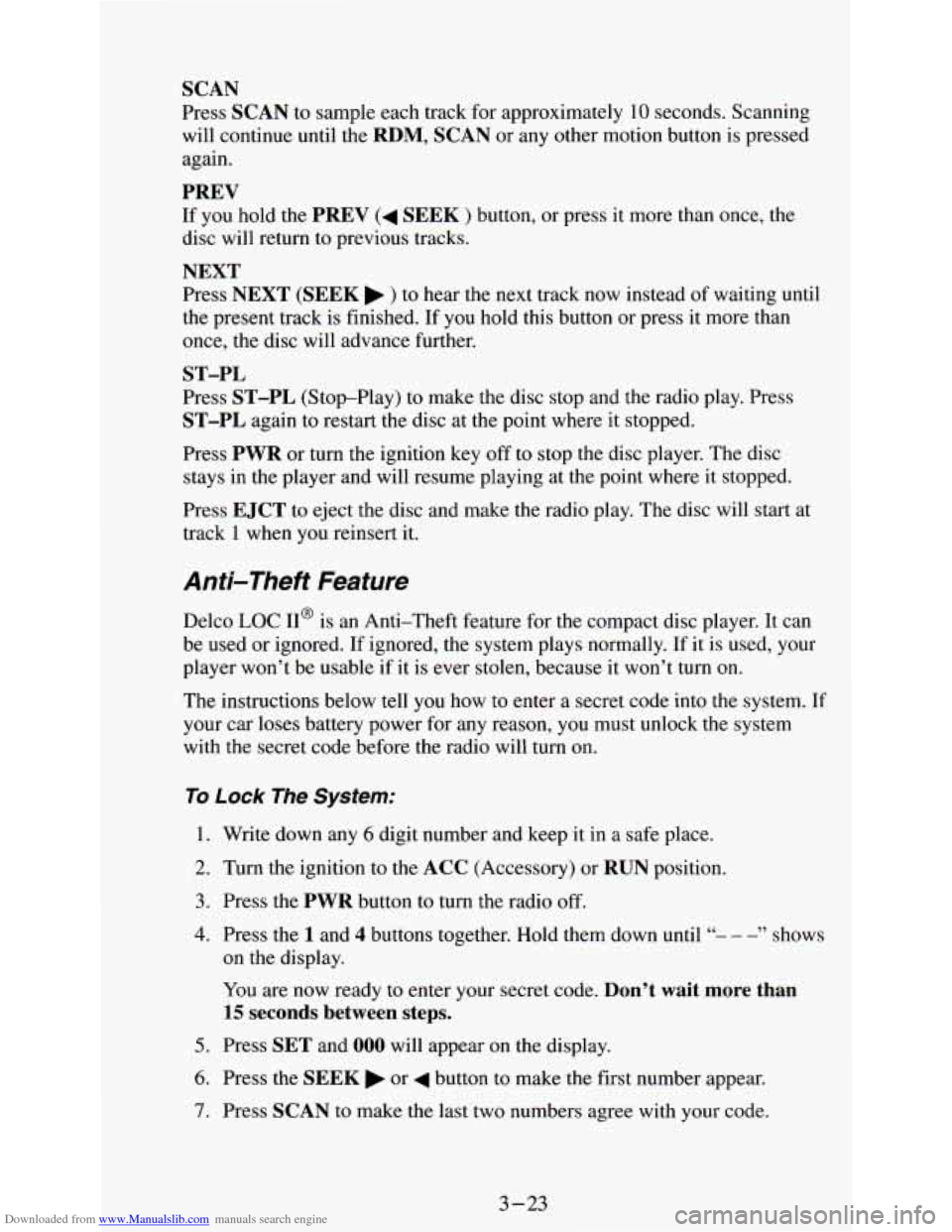
Downloaded from www.Manualslib.com manuals search engine SCAN
Press SCAN to sample each track for approximately 10 seconds. Scanning
will continue until the
RDM, SCAN or any other motion button is pressed
again.
PREV
If you hold the PREV (4 SEEK ) button, or press it more than once, the
disc will return to previous tracks.
NEXT
Press NEXT (SEEK b ) to hear the next track now instead of waiting until
the present track
is finished. If you hold this button or press it more than
once, the disc will advance further.
ST-PL
Press ST-PL (Stop-Play) to make the disc stop and the radio play. Press
ST-PL again to restart the disc at the point where it stopped.
Press
PWR or turn the ignition key off to stop the disc player. The disc
stays in the player and will resume playing at the point where
it stopped.
Press
EJCT to eject the disc and make the radio play. The disc will start at
track
1 when you reinsert it.
Anti-Theft Feature
Delco LOC II@ is an Anti-Theft feature for the compact disc player. It can
be used or ignored.
If ignored, the system plays normally. If it is used, your
player won’t be usable if
it is ever stolen, because it won’t turn on.
The instructions below tell you how
to enter a secret code into the system. If
your car loses battery power for any reason, you must unlock the system
with the secret code before
the radio will turn on.
To Lock The System:
1. Write down any 6 digit number and keep it in a safe place.
2. Turn the ignition to the ACC (Accessory) or RUN position.
3. Press the PWR button to turn the radio off.
4. Press the 1 and 4 buttons together. Hold them down until “- - -” shows
on the display.
You are now ready to enter your secret code. Don’t wait more than
15 seconds between steps.
5. Press SET and 000 will appear on the display.
6. Press the SEEK b or 4 button to make the first number appear.
7. Press SCAN to make the last two numbers agree with your code.
3-23
Page 152 of 340
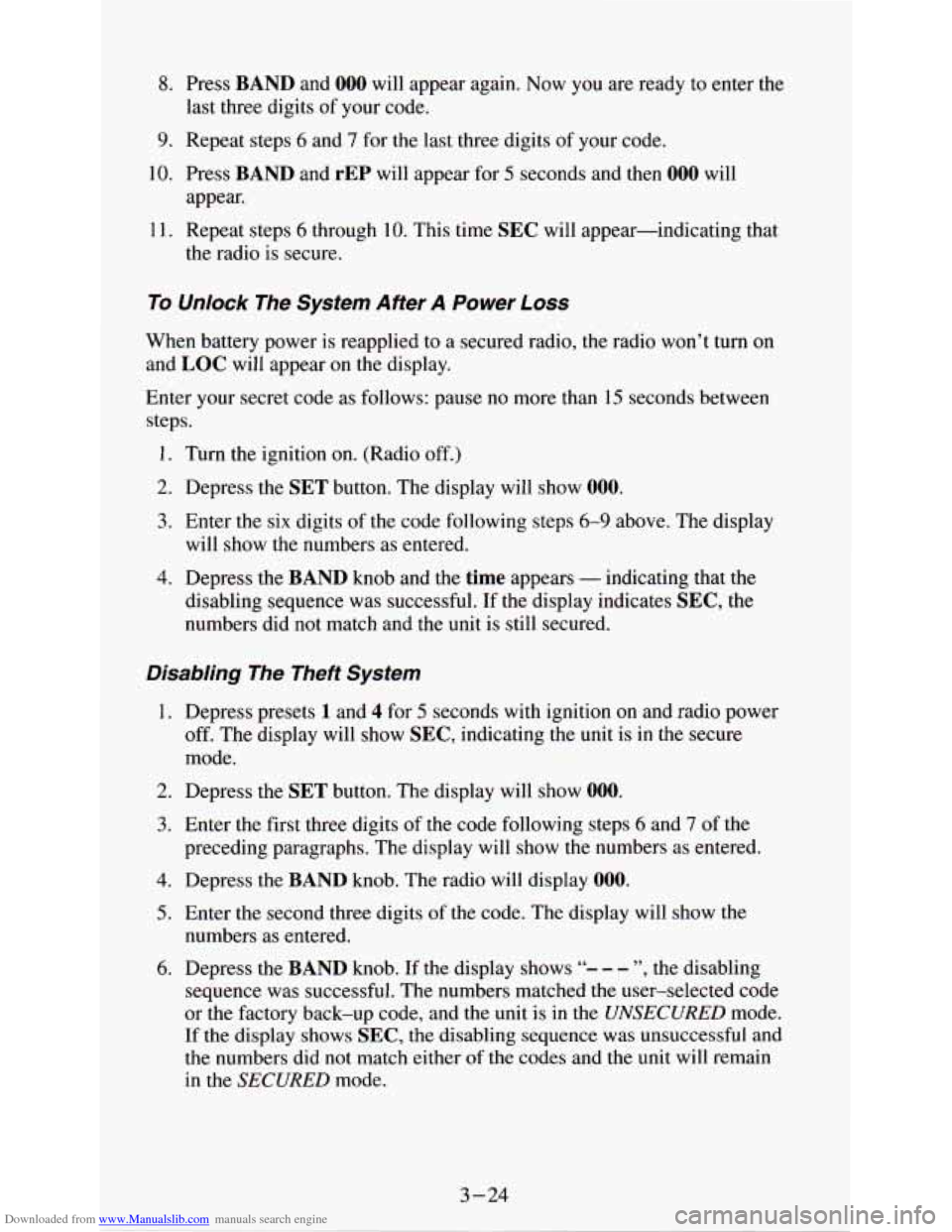
Downloaded from www.Manualslib.com manuals search engine 8. Press BAND and 000 will appear again. Now you are ready to enter the
last three digits of your code.
9. Repeat steps 6 and 7 for the last three digits of your code.
10. Press
BAND and rEP will appear for 5 seconds and then 000 will
11. Repeat steps
6 through 10. This time SEC will appear-indicating that
appear.
the radio
is secure.
To Unlock The System After A Power Loss
When battery power is reapplied to a secured radio, the radio won’t turn on
and
LOC will appear on the display.
Enter your secret code as follows: pause no more than
15 seconds between
steps.
1. Turn the ignition on. (Radio off.)
2. Depress the SET button. The display will show 000.
3. Enter the six digits of the code following steps 6-9 above. The display
4. Depress the BAND knob and the time appears - indicating that the
disabling sequence was successful. If the display indicates
SEC, the
numbers did not match and the unit is still secured.
will show the numbers as entered.
Disabling The Theft System
1.
2.
3.
4.
5.
6.
Depress presets 1 and 4 for 5 seconds with ignition on and radio power
off. The display will show
SEC, indicating the unit is in the secure
mode.
Depress the
SET button. The display will show 000.
Enter the first three digits of the code following steps 6 and 7 of the
preceding paragraphs. The display
will show the numbers as entered.
Depress
the BAND knob. The radio will display 000.
Enter the second three digits of the code. The display will show the
numbers as entered.
Depress the
BAND knob. If the display shows bb- - - ”, the disabling
sequence was successful. The numbers matched the user-selected code
or the factory back-up code, and the unit
is in the UNSECURED mode.
If the display shows
SEC, the disabling sequence was unsuccessful and
the numbers did not match either of the codes and the unit will remain
in the SECURED mode.
3-24
Page 153 of 340
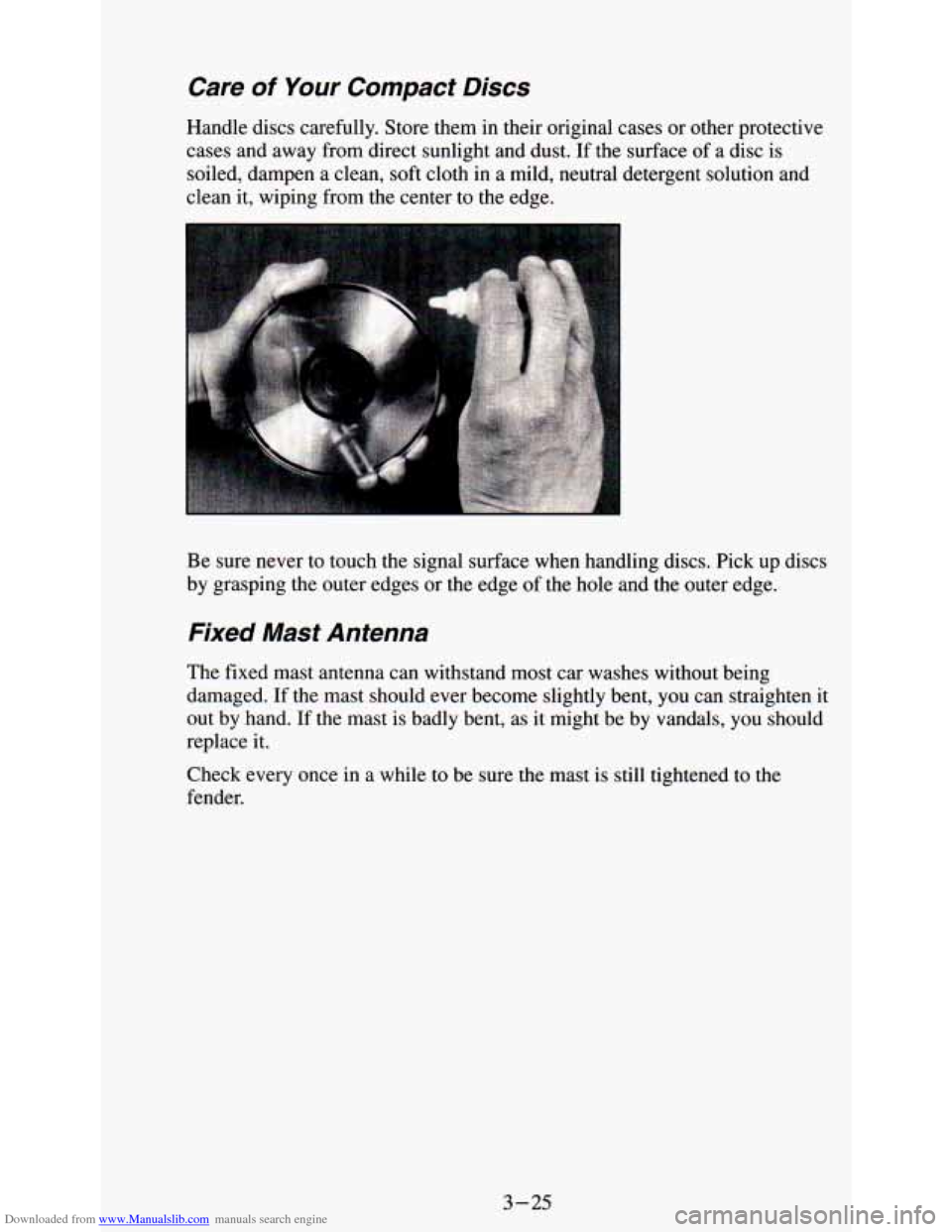
Downloaded from www.Manualslib.com manuals search engine Care of Your Compact Discs
Handle discs carefully. Store them in their original cases or other protective
cases and away from direct sunlight and dust. If the surface of a disc is
soiled, dampen a clean, soft cloth in a mild, neutral detergent solution and
clean it, wiping from the center to the edge.
Be sure never to touch the signal surface when handling discs. Pick up discs
by grasping the outer edges or the edge of the hole and the outer edge.
Fixed Mast Antenna
The fixed mast antenna can withstand most car washes without being
damaged. If the mast should ever become slightly bent, you can straighten it
out by hand. If the mast is badly bent, as it might be by vandals, you should
replace it.
Check every once in
a while to be sure the mast is still tightened to the
fender.
3-25
Page 154 of 340

Downloaded from www.Manualslib.com manuals search engine Notes
3-26
Page 155 of 340
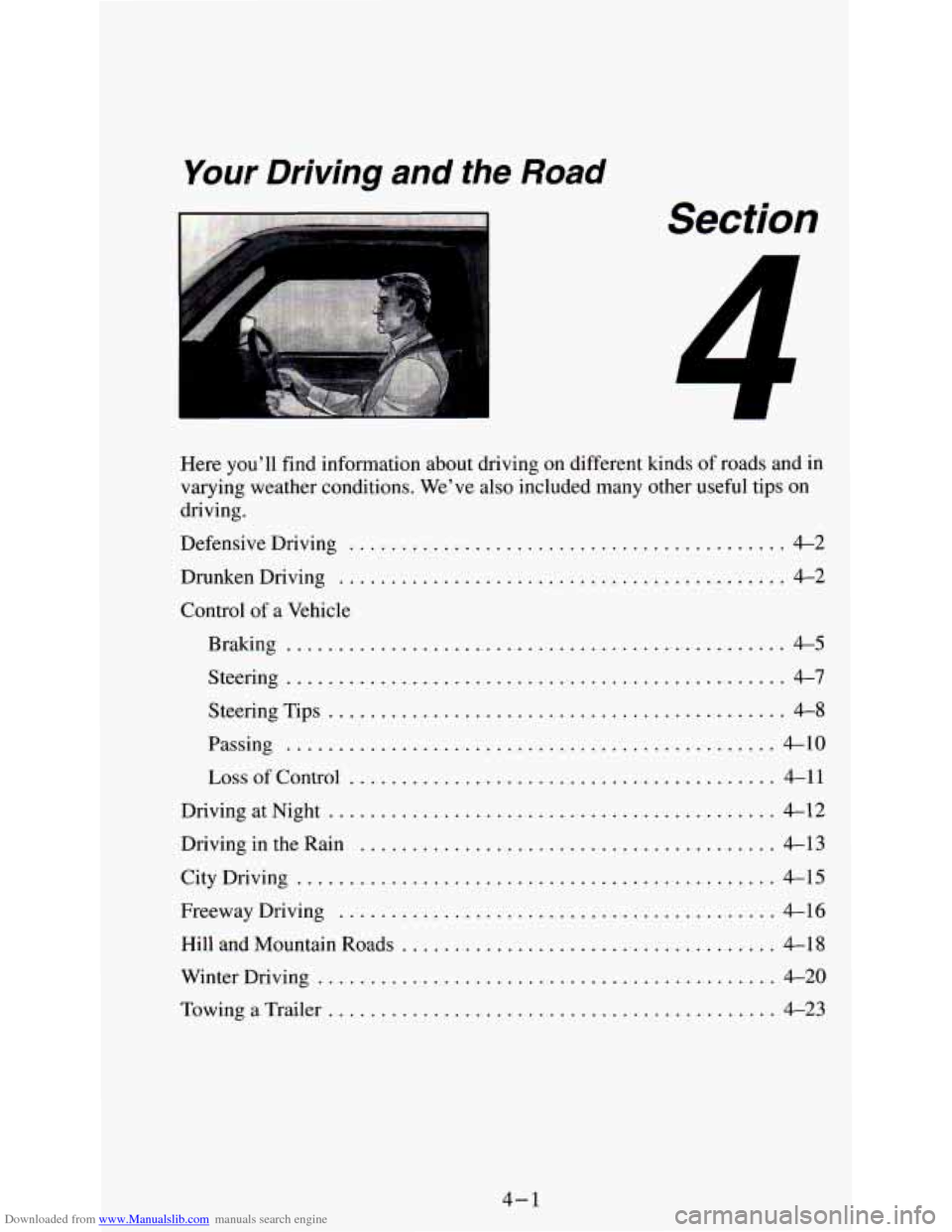
Downloaded from www.Manualslib.com manuals search engine Your Driving and the Road
Section
.......
--_-. ~ ~ - - ~ - - - -. . 4-2
...................... 4-2
Here
you’ll find information about driving on different kinds of roads and in
varying weather conditions. We’ve also included many other useful tips on
driving.
Defensive Driving
...
Drunken Driving . I
Control of a Vehicle
Braking
.............................................. 4-5
Steering
................................................ 4-7
Steering Tips .............. .................... 4-8
Passing ............................................... 4-10
Loss of Control ..... .......... 4-11
Driving at Night
......... ........ 4-12
Driving in the Rain
........................................ 4-13
CityDriving
............................................ 4-15
Freeway Driving
............... ........... ...... 4-16
Winter Driving
................. ......... ...... 4-20
TowingaTrailer
........................................... 4-23
Hill and
Mountain Roads
.................................. 4-1 8
......................
................
4-1
Page 156 of 340
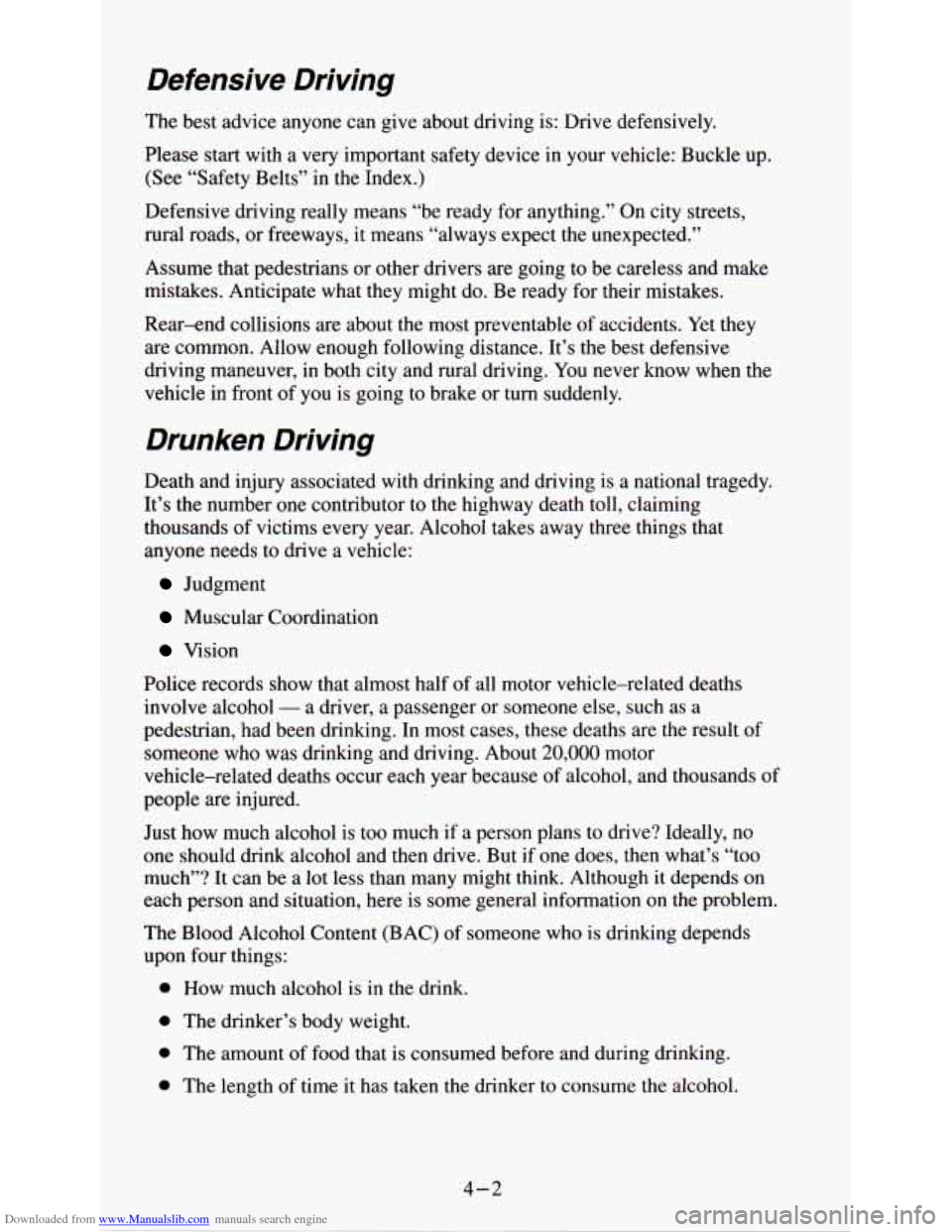
Downloaded from www.Manualslib.com manuals search engine Defensive Driving
The best advice anyone can give about driving is: Drive defensively.
Please start
with a very important safety device in your vehicle: Buckle up.
(See “Safety Belts” in the Index.)
Defensive driving really means “be ready for anything.” On city streets,
rural roads, or freeways,
it means “always expect the unexpected.”
Assume that pedestrians or other drivers are going to be careless and make
mistakes. Anticipate what they might do. Be ready for their mistakes.
Rear-end collisions are about the most preventable of accidents. Yet they
are common. Allow enough following distance. It’s the best defensive
driving maneuver, in both city and rural driving. You never know when the
vehicle in front of you is going to brake or
turn suddenly.
Drunken Driving
Death and injury associated with drinking and driving is a national tragedy.
It’s
the number one contributor to the highway death toll, claiming
thousands of victims every year. Alcohol takes away three things that
anyone needs to drive a vehicle:
Judgment
Muscular Coordination
Vision
Police records show that almost half of all motor vehicle-related deaths
involve alcohol
- a driver, a passenger or someone else, such as a
pedestrian, had been drinking. In most cases, these deaths are the result of
someone who was drinking and driving. About
20,000 motor
vehicle-related deaths occur each year because of alcohol, and thousands of
people are injured.
Just how much alcohol is too much if a person plans to drive? Ideally, no
one should drink alcohol and then drive.
But if one does, then what’s “too
much”? It can
be a lot less than many might think. Although it depends on
each person and situation, here is some general information on the problem.
The Blood Alcohol Content (BAC) of someone who is drinking depends
upon four things:
0 How much alcohol is in the drink.
0 The drinker’s body weight.
0 The amount of food that is consumed before and during drinking.
0 The length of time it has taken the drinker to consume the alcohol.
4-2
Page 157 of 340
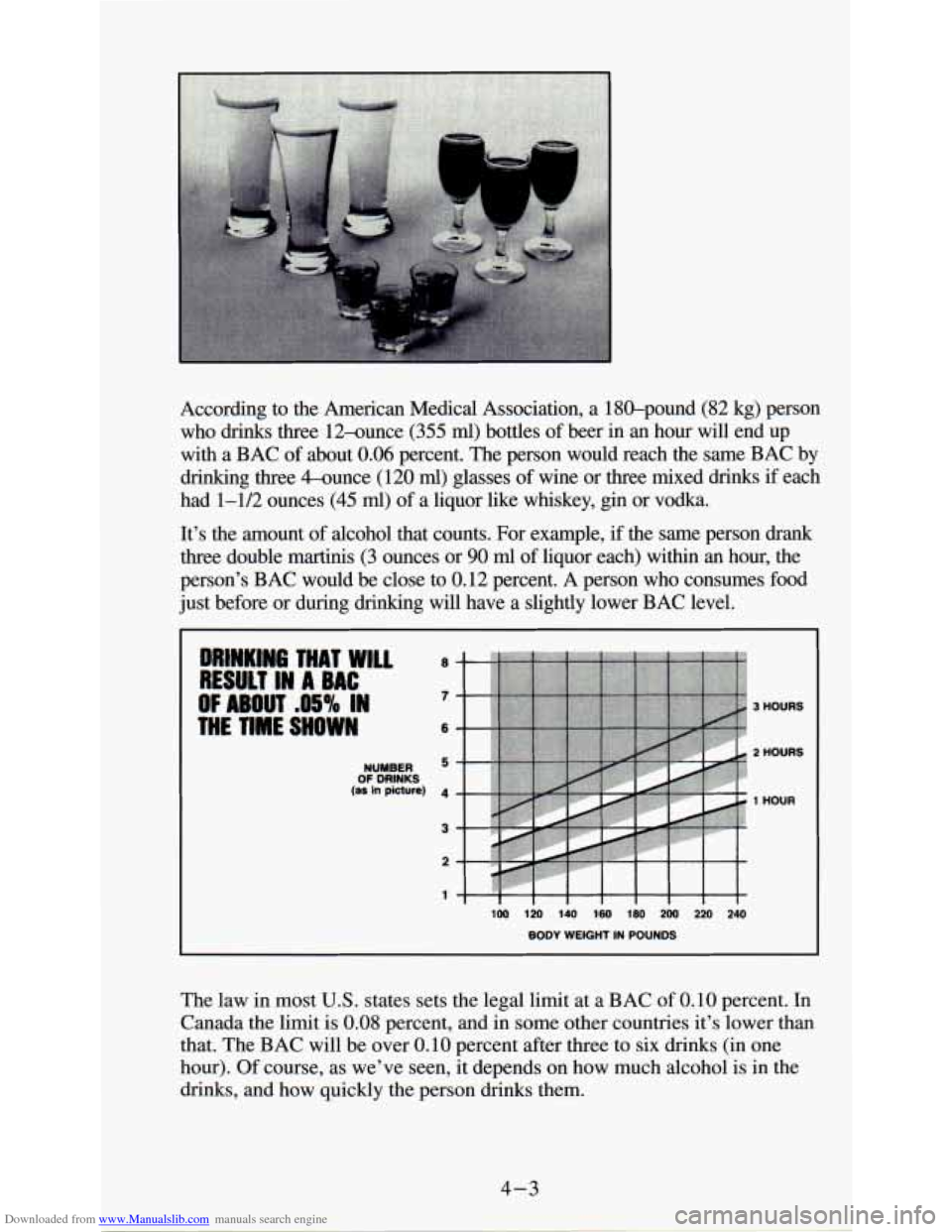
Downloaded from www.Manualslib.com manuals search engine 1 (82 kg
According to the American Medical Association, a 180-pounc ;) person
who drinks three 12-ounce
(355 ml) bottles of beer in an hour will end up
with a BAC
of about 0.06 percent. The person would reach the same BAC by
drinking three LCounce (120
ml) glasses of wine or three mixed drinks if each
had 1-1/2 ounces
(45 ml) of a liquor like whiskey, gin or vodka.
It’s the amount of alcohol that counts. For example,
if the same person drank
three double martinis (3 ounces or 90 ml of liquor each) within an hour, the
person’s BAC would be close
to 0.12 percent. A person who consumes food
just before or during drinking will have a slightly lower BAC level.
3 HOURS
1 HOURS
1 HOUR
The law in most U.S. states sets the legal limit at a BAC of 0.10 percent. In
Canada the limit is
0.08 percent, and in some other countries it’s lower than
that. The BAC will be over 0.10 percent after three to six drinks (in one
hour). Of course, as we’ve seen, it depends on how much alcohol is in the
drinks, and how quickly the person
drinks them.
4-3
Page 158 of 340
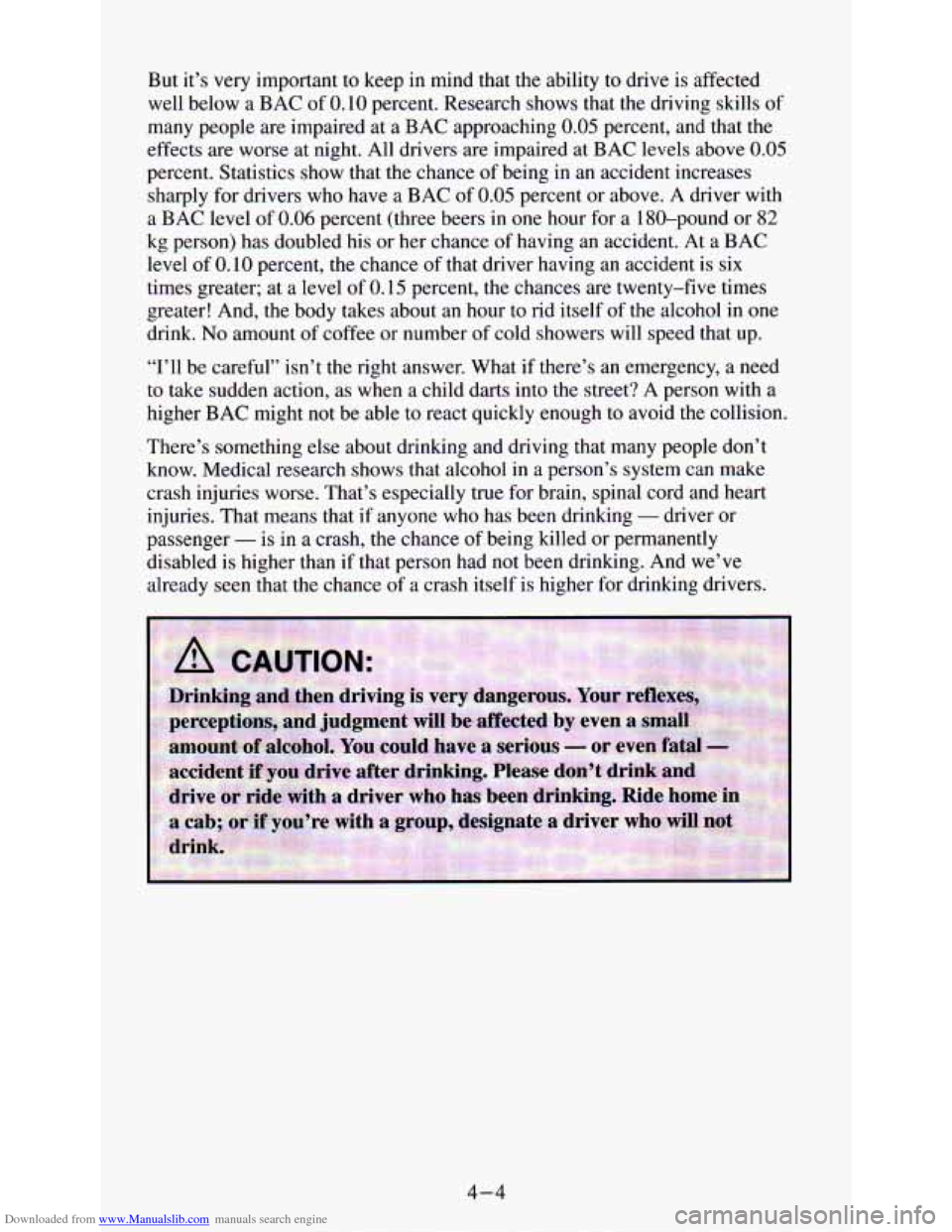
Downloaded from www.Manualslib.com manuals search engine But it’s very important to keep in mind that the ability to drive is affected
well below a BAC of
0.10 percent. Research shows that the driving skills of
many people are impaired at a BAC approaching
0.05 percent, and that the
effects are worse at night. All drivers are impaired at BAC levels above
0.05
percent. Statistics show that the chance of being in an accident increases
sharply for drivers who have a BAC of
0.05 percent or above. A driver with
a BAC level of
0.06 percent (three beers in one hour for a 180-pound or 82
kg person) has doubled his or her chance of having an accident. At a BAC
level of
0.10 percent, the chance of that driver having an accident is six
times greater; at
a level of 0.15 percent, the chances are twenty-five times
greater! And, the body takes about an hour to rid itself of the alcohol
in one
drink.
No amount of coffee or number of cold showers will speed that up.
“I’ll
be careful’’ isn’t the right answer. What if there’s an emergency, a need
to take sudden action, as when a child darts into the street?
A person with a
higher BAC might not
be able to react quickly enough to avoid the collision.
There’s something else about drinking and driving that many people don’t
know. Medical research shows that alcohol in
a person’s system can make
crash injuries worse. That’s especially true for brain, spinal cord and heart
injuries. That means that
if anyone who has been drinking - driver or
passenger
- is in a crash, the chance of being killed or permanently
disabled is higher than if that person had not been drinking. And we’ve
already seen that the chance of
a crash itself is higher for drinking drivers.
Drinking and then drivin! very mg Yo1 reflexes!
perceptions, and judgment will be affected by even a small
amount of alcohol. You could have a serious
- or even fata
*!‘i;:i:‘.accident if you drive after drinking. Please don’\
t drink and
‘‘:I’ ... . idr rive .. . or ride with a driver who has been drinking. Ride home in I
.. :ll
’,/.,’
4-4
Page 159 of 340
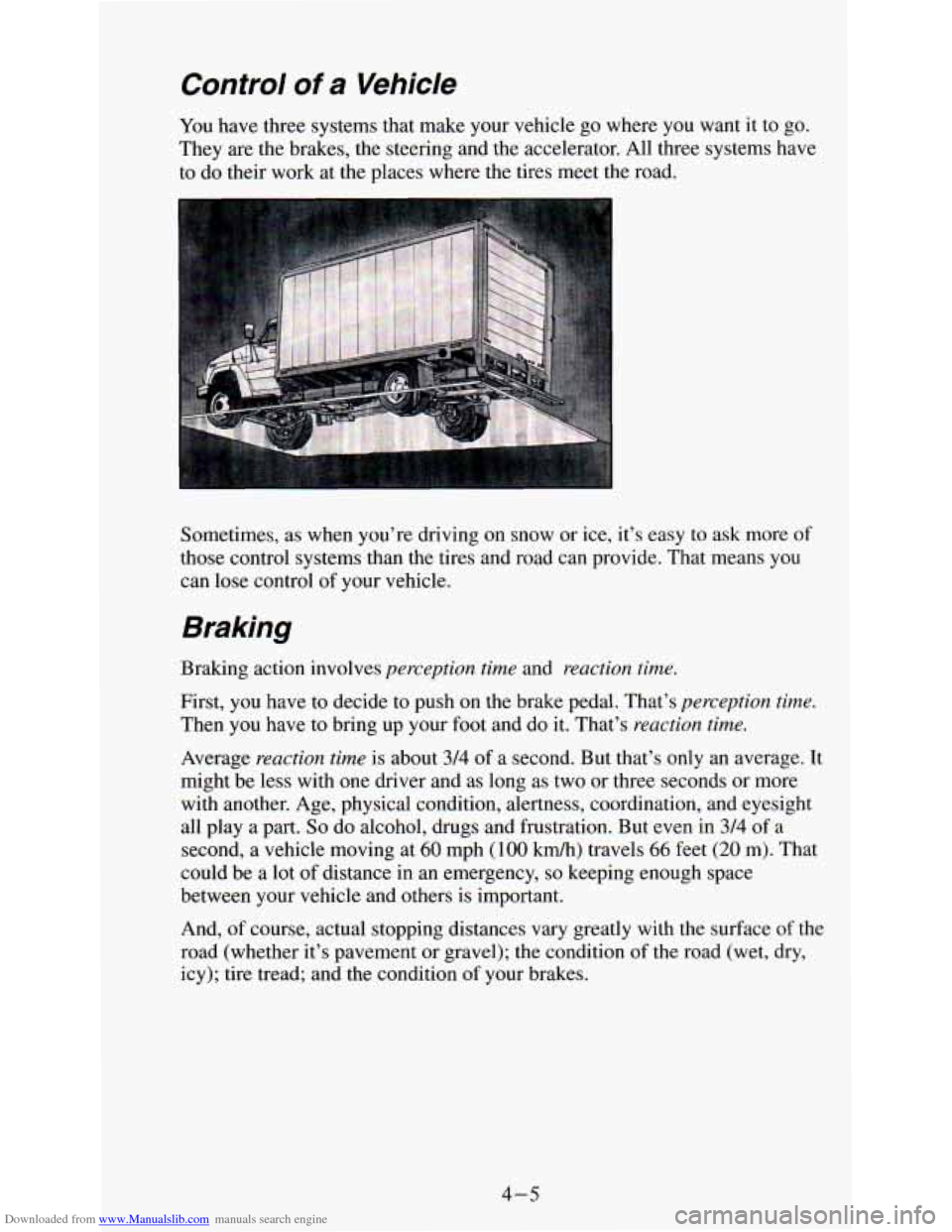
Downloaded from www.Manualslib.com manuals search engine Control of a Vehicle
You have three systems that make your vehicle go where you want it to go.
They are the brakes, the steering and the accelerator. All three systems have
to do their work at the places where the tires meet the road.
Sometimes, as when you’re driving on snow or ice, it’s easy to ask more
of
those control systems than the tires and road can provide. That means you
can lose control
of your vehicle.
Braking
Braking action involves perception time and reaction time.
First, you have to decide to push on the brake pedal. That’s perception time.
Then you have to bring up your foot and do it. That’s reaction time.
Average reaction time is about 314 of a second. But that’s only an average. It
might be less with one driver and as long as two or three seconds or more
with another. Age, physical condition, alertness, coordination, and eyesight
all play a part.
So do alcohol, drugs and frustration. But even in 314 of a
second, a vehicle moving at
60 mph (100 km/h) travels 66 feet (20 m). That
could be a lot
of distance in an emergency, so keeping enough space
between your vehicle and others is important.
And,
of course, actual stopping distances vary greatly with the surface of the
road (whether it’s pavement or gravel); the condition
of the road (wet, dry,
icy); tire tread; and the condition of your brakes.
4-5
Page 160 of 340
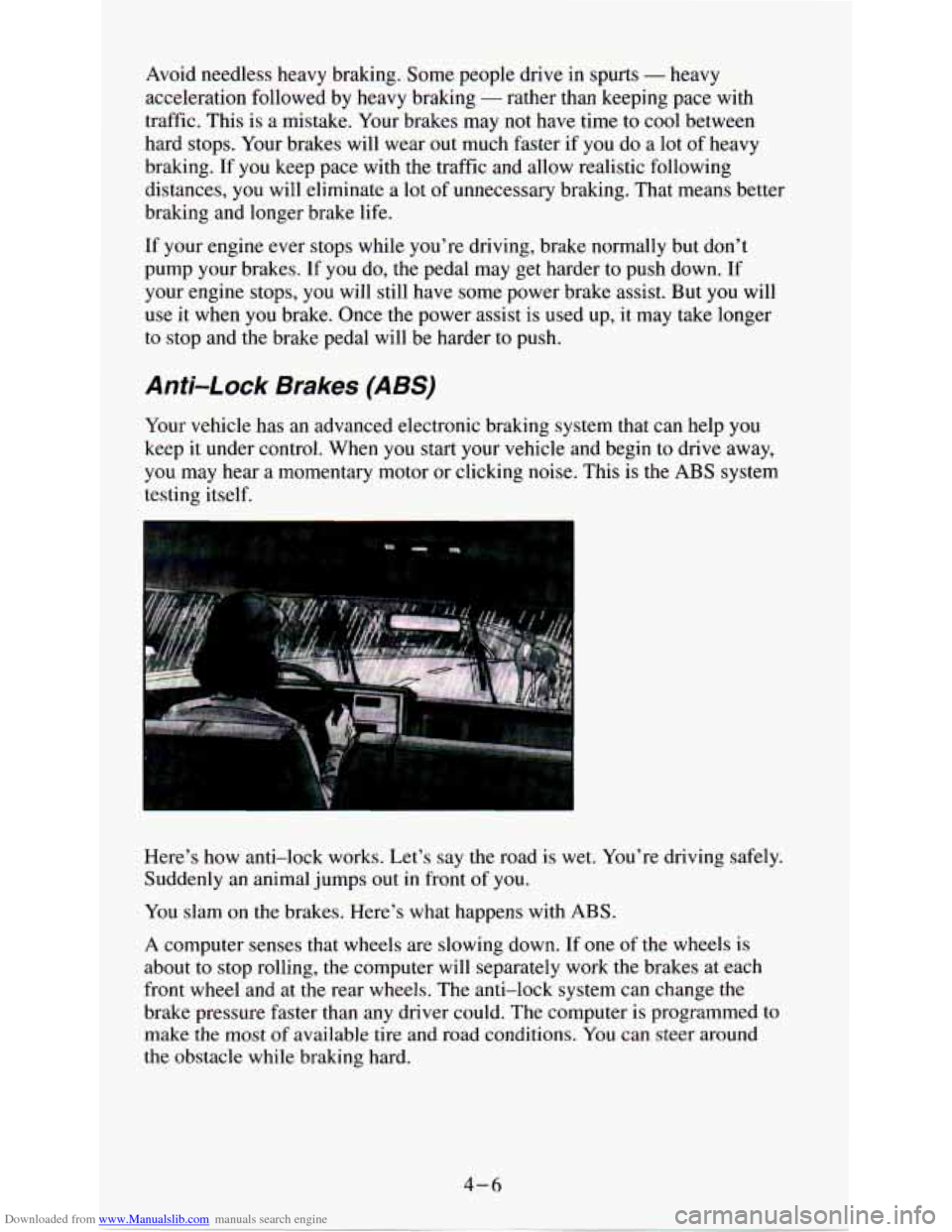
Downloaded from www.Manualslib.com manuals search engine Avoid needless heavy braking. Some people drive in spurts - heavy
acceleration followed by heavy braking
- rather than keeping pace with
traffic. This
is a mistake. Your brakes may not have time to cool between
hard stops. Your brakes will wear out much faster if you do a lot
of heavy
braking. If you keep pace with the traffic and allow realistic followin\
g
distances, you will eliminate a
lot of unnecessary braking. That means better
braking and longer brake life.
If your engine ever stops while you're driving, brake normally but don't
pump your brakes. If you do, the pedal may get harder to push down. If
your engine stops, you will still have some power brake assist. But you will
use it when you brake. Once the power assist is used up,
it may take longer
to stop and the brake pedal will be harder to push.
Anti-Lock Brakes (ABS)
Your vehicle has an advanced electronic braking system that can help you
keep it under control. When
you start your vehicle and begin to drive away,
you may hear a momentary motor or clicking noise. This is the
ABS system
testing itself.
Here's how anti-lock works. Let's say the road
is wet. You're driving safely.
Suddenly an animal jumps out in front of you.
You slam on the brakes. Here's what happens with
ABS.
A computer senses that wheels are slowing down. If one of the wheels is
about to stop rolling,
the computer will separately work the brakes at each
front wheel and at the rear wheels. The anti-lock system can change the
brake pressure faster than any driver could. The computer is programmed
to
make the most of available tire and road conditions. You can steer around
the obstacle while braking hard.
4-6